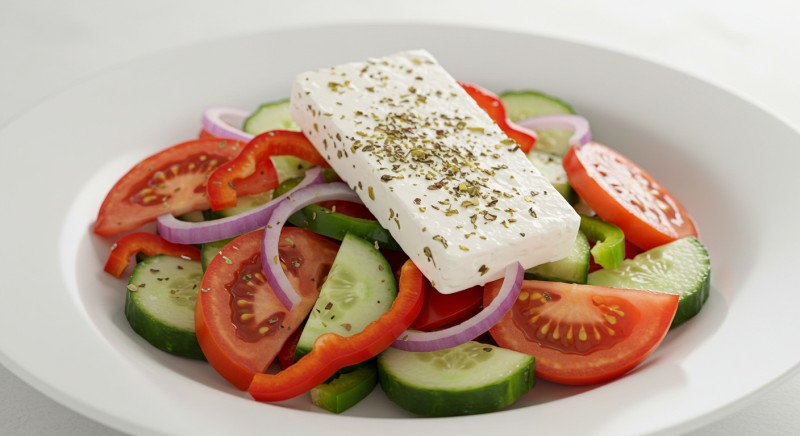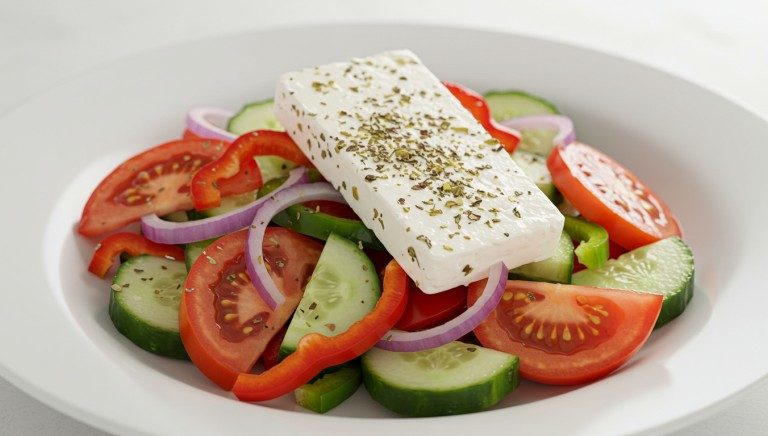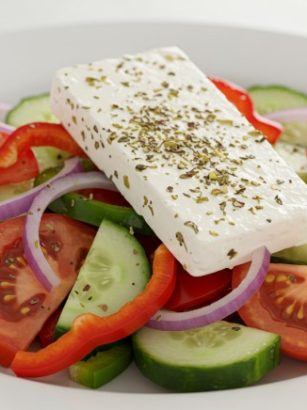Greek Salad is popular recipes to add flavour in dishes.

Prep Time: 10 mins
Cook Time: 0 mins
Total Time: 10 mins
Course: Salad
Cuisine: Greek
Servings: 4
Calories: 250/serving
Materials:
Knife, mixing bowl
Ingredients:
4 tomatoes, chopped
1 cucumber, sliced
1 red onion, thinly sliced
1 green bell pepper, sliced
200g feta cheese
Kalamata olives (½ cup)
Olive oil (3 tbsp)
Oregano (1 tsp)
Salt/pepper to taste
Method:
Combine veggies in a bowl.
Top with feta, olives, olive oil, and seasoning. Toss lightly.
Servings:
Greek Salad (Horiatiki) is a vibrant, refreshing dish with tomatoes, cucumbers, red onions, Kalamata olives, and feta cheese, all dressed in olive oil and herbs. It pairs perfectly with a variety of sides that balance the freshness and complement its Mediterranean flavors. Here are some great accompaniments:
Classic Greek Pairings:
Pita Bread – Soft, warm pita for scooping up the salad or served with dips.
Tzatziki – A cool, creamy yogurt and cucumber dip with garlic and dill, perfect for dipping pita or drizzling over the salad.
Spanakopita – A savory spinach and feta-filled pastry wrapped in flaky phyllo dough, adding a rich, earthy element to the meal.
Dolma (Stuffed Grape Leaves) – Rice, herbs, and sometimes meat wrapped in grape leaves, providing a tangy, savory bite.
Grilled Souvlaki – Skewered and grilled meat (typically chicken, pork, or lamb), adding a smoky, flavorful protein to the meal.
Vegetable-Based Sides:
Baked Eggplant with Feta (Melitzanes Papoutsakia) – Roasted eggplant topped with a tomato sauce and feta cheese, offering a creamy and savory side.
Gigantes Plaki – Greek baked beans in a rich tomato sauce, providing a hearty and comforting addition.
Greek Lemon Potatoes – Roasted potatoes with garlic, lemon, and oregano, crispy on the outside and tender on the inside.
Grilled Vegetables – A mix of zucchini, bell peppers, and onions, charred and seasoned with olive oil and oregano.
Horta (Greek Greens) – Blanched wild greens drizzled with olive oil and lemon, offering a healthy and earthy addition.
Hearty & Flavorful Additions:
Moussaka – A layered casserole made with eggplant, ground meat, and béchamel sauce, rich and savory.
Lamb Gyros – Tender lamb wrapped in pita with tomatoes, onions, and tzatziki sauce, adding a deliciously savory and satisfying element.
Feta and Olives Plate – A simple plate of cubed feta cheese and Kalamata olives to complement the salad.
Saganaki (Fried Cheese) – A crispy, golden fried cheese, often served with a squeeze of lemon, offering a rich and indulgent side.
Pastitsio – A Greek pasta dish with ground meat, béchamel sauce, and tomato, adding a comforting, hearty option.
Refreshing Drinks to Pair:
Retsina – A Greek white wine with a distinct pine resin flavor, perfect for complementing the freshness of the salad.
Ouzo – A traditional Greek anise-flavored spirit, refreshing and aromatic, great for pairing with Mediterranean dishes.
Greek Frappe – A frothy, iced coffee with a bit of sweetness, ideal for a refreshing beverage.
Description
Greek Salad (Horiatiki), also known as Horiatiki Salata, is a fresh, vibrant, and simple dish that embodies the flavors of the Mediterranean. This salad is made with ripe tomatoes, cucumbers, red onions, Kalamata olives, and feta cheese, and dressed with extra virgin olive oil, oregano, and a touch of red wine vinegar. Unlike most Western-style salads, it’s served in large chunks, emphasizing the quality and natural flavor of each ingredient.
The Vegetables:
The salad typically features sliced tomatoes, cucumbers, and red onions, all cut into large chunks to preserve texture and freshness.
The Cheese:
Feta cheese is the iconic ingredient, often served in a block rather than crumbled, adding richness and saltiness.
The Olives:
Kalamata olives are the traditional choice, offering a briny, slightly bitter contrast to the sweetness of the vegetables.
The Dressing:
The dressing is simple, made with extra virgin olive oil, red wine vinegar, a pinch of dried oregano, and sometimes salt and pepper. This allows the natural flavors of the ingredients to shine.
The Serving Style:
Greek Salad is often served as a side dish with grilled meats or seafood, or it can be a refreshing main dish when accompanied by crusty bread or pita.
Benefits
This dish is not only delicious but also packed with health benefits:
Rich in Healthy Fats:
The extra virgin olive oil used in the dressing is a good source of monounsaturated fats, which promote heart health and reduce inflammation.
High in Fiber:
The vegetables—tomatoes, cucumbers, and red onions—provide plenty of fiber, which aids digestion and helps maintain healthy blood sugar levels.
Packed with Vitamins & Minerals:
Greek Salad is a great source of vitamin C from tomatoes and cucumbers, potassium from olives, and calcium from feta cheese.
Antioxidants:
The olives and oregano provide antioxidants, which help fight inflammation and support immune function.
Low in Carbs & Gluten-Free:
This dish is naturally low-carb and gluten-free, making it suitable for a variety of dietary preferences.
FAQ
Q1: Can I make Greek Salad in advance?
A: Greek Salad is best served fresh because the vegetables can release moisture over time. However, you can prep the ingredients (slice veggies, crumble feta, etc.) and store them separately in the fridge for a few hours before tossing everything together.
Q2: Can I use a different cheese instead of feta?
A: Feta is the classic choice, but you can substitute it with ricotta salata or goat cheese for a slightly different flavor and texture.
Q3: Can I add other ingredients to Greek Salad?
A: While traditional Greek Salad sticks to the basics, you can customize it with ingredients like:
Green bell peppers for crunch.
Capers for extra brininess.
Fresh herbs like parsley or mint for added freshness.
Q4: How can I make Greek Salad vegan?
A: Simply omit the feta or replace it with a vegan feta cheese alternative.
Q5: How do I store leftover Greek Salad?
A: If you have leftover salad, store the dressing separately from the vegetables to prevent them from getting soggy. The vegetables and olives can last in the fridge for 1–2 days, but the salad is best when eaten fresh.
Q6: What can I serve Greek Salad with?
A: Greek Salad pairs well with:
Grilled meats like chicken, lamb, or beef.
Seafood like grilled shrimp or fish.
Pita bread or crusty bread for dipping.
Tzatziki for an extra creamy dip on the side.
Q7: How can I make the dressing more flavorful?
A: You can enhance the dressing by adding a small amount of garlic, lemon juice, or a dash of honey for sweetness.
Main Dish
Breakfast Recipe
Drinks Recipe
Side dish Recipe
Salad Recipes
Soup Recipes
For more informations, visit our official YouTube channel , Facebook , LinkedIn , Pinterest , Instagram.



































